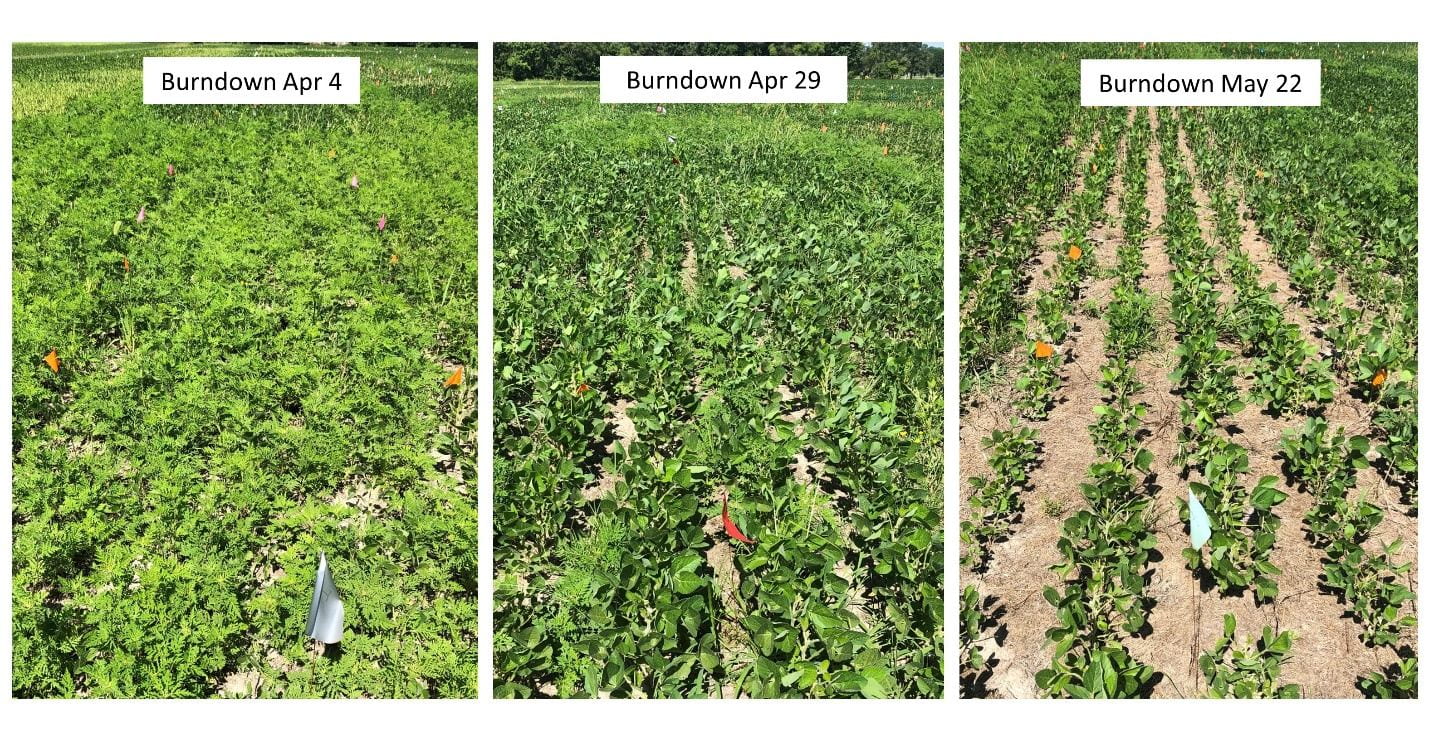Sarah Hirsh, Agriculture Agent
University of Maryland Extension, Somerset County

Figure 1. Common ragweed in soybean field when burndown herbicide was applied April 4, April 29, and May 22. Photos taken 2 July 2019.Herbicide resistant common ragweed (Ambrosia artemisiifolia L.) is prevalent on the Lower Eastern Shore. In 2019, common ragweed populations were found to have two or three-way mode-of-action resistance on the Eastern Shore, and farmers have reported that herbicide-resistant ragweed prevalence is increasing. Some populations of common ragweed on the Eastern shore are resistant to glyphosate (Roundup) (Group 9) herbicide, ALS inhibiting (e.g., FirstRate, Raptor) (Group 2) herbicide, and/or PPO inhibiting (e.g., Valor, Reflex) (Group 14) herbicide.
Common ragweed is one of the first summer annual weeds to emerge in the spring, and early-season management of common ragweed is strongly dependent upon reducing ragweed emergence and controlling ragweed populations prior to soybean planting. A research study was performed on three farms in Somerset and Worcester counties, focused on reducing ragweed emergence and early-spring growth through the combination of delaying cover crop burn-down in order to increase cover crop biomass and competition with weeds, and evaluating preemergence herbicide control. All of the on-farm trials had a wheat cover crop. We evaluated three cover crop termination dates—early April, early May, and at soybean planting. The burndown herbicides used were glyphosate + 2,4-D for the pre-planting applications and glyphosate + Liberty for the soybean planting application. Soybean was planted May 18 to June 3 at the sites.
Our results indicated that there was higher common ragweed prevalence when cover crops were terminated early April than when terminated early May or at planting (Figure 1). Growers will often apply two burndown applications of herbicide prior to planting—a first application to kill cover crops, and a second application at soybean planting. Spraying two herbicide applications prior to ragweed planting did not improve common ragweed control as compared to spraying only one herbicide application at planting time. In fact, at two of the three on-farm trials, spraying just one herbicide application at soybean planting provided even better control of ragweed than spraying two herbicide applications.
Including a residual herbicide (Linex + Dimetric) at soybean planting decreased ragweed prevalence during the growing season, as compared to applying an herbicide at planting that did not include a residual herbicide. The lowest ragweed prevalence occurred when the cover crop was sprayed with a burndown + residual herbicide only once at soybean planting time.
There is concern that allowing a cover crop to grow until soybean planting may decrease yields. We did not find soybean yields to be lower when cover crops were allowed to grow later in the spring.
We also investigated the effectiveness of residual herbicide products—Command (clomazone), Linex 4L (linuron), Dimetric (metribuzin), Command + Linex, Command + Dimetric, and Linex + Dimetric—on herbicide resistant common ragweed emergence and growth. These residual herbicides were applied at soybean planting time. The residual herbicides Command, Linex, and Dimetric and combinations of Command + Dimetric and Linex + Dimetric decreased ragweed prevalence as compared to a burndown that did not include a residual herbicide. There were no differences in soybean yield for any of the residual herbicide treatments as compared to no residual herbicide control.
Acknowledgements
This research was funded by the Maryland Soybean Board.

